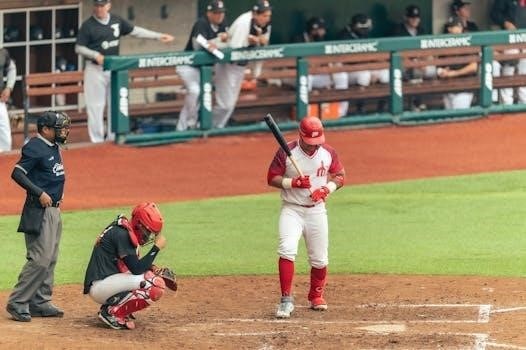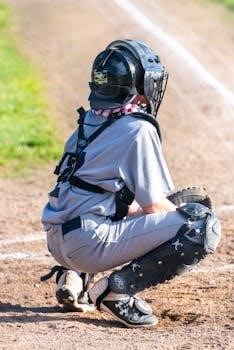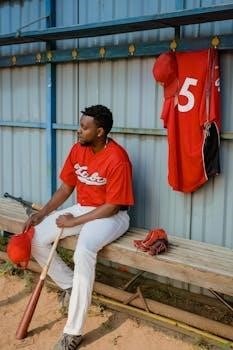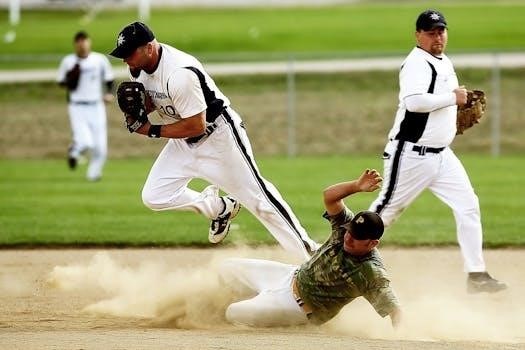Baseball gloves are crafted using a variety of materials‚ each impacting performance and longevity. Traditionally‚ leather is favored‚ but modern synthetics like PVC and PU are increasingly used. These choices affect a glove’s weight‚ durability‚ and feel.
Overview of Baseball Glove Construction
The construction of a baseball glove involves several key steps‚ starting with selecting premium materials like leather or synthetics. The process includes die-cutting these materials into specific shapes for the shell‚ lining‚ padding‚ and webbing. These components are then assembled using stitching‚ with reinforced areas for durability. Historically‚ designs have evolved from simple protective gear to performance-enhancing tools‚ with modern gloves using advanced materials and techniques. Gloves are designed with specific positions in mind such as infield‚ outfield‚ catcher‚ first base‚ and pitcher‚ which influences the pocket design and overall construction. The use of plastic and nylon for reinforcement is also common. The manufacturing process requires skilled craftsmen to create each glove‚ ensuring quality and precision. This meticulous approach is crucial for optimal performance and player comfort.

Traditional Materials
Traditional baseball gloves mainly utilize leather‚ known for its durability and feel. Full-grain leather and steerhide are popular choices‚ offering strength and a classic aesthetic.
Leather⁚ The Classic Choice
Leather has been the cornerstone of baseball glove construction for generations‚ revered for its inherent qualities that enhance performance and longevity. Its natural feel provides players with a unique connection to the ball‚ allowing for better control and a more intuitive catching experience. The material’s ability to mold to the player’s hand over time results in a custom fit that is both comfortable and functional. Furthermore‚ the durability of leather ensures that a well-maintained glove will withstand the rigors of regular play‚ making it a favored option for serious athletes. The breathability of leather also helps to keep the hand cool and dry‚ adding to the overall comfort and performance on the field. Leather’s classic look also makes it a favorite among players.
Full-Grain Leather Properties
Full-grain leather‚ the highest quality leather used in baseball gloves‚ retains the entire grain layer‚ making it exceptionally durable and resistant to wear and tear. This type of leather is known for its robust nature‚ offering superior protection while maintaining a natural feel. Its tight grain structure provides excellent resistance against moisture and stretching‚ contributing to the glove’s overall longevity. Full-grain leather develops a unique patina over time‚ adding to its aesthetic appeal and character. The natural fibers of full-grain leather also allow it to breathe‚ preventing excessive moisture buildup inside the glove during intense gameplay. This promotes comfort and a sure grip. Its ability to mold to the player’s hand makes it a highly sought-after material for serious players.
Steerhide⁚ Durability and Strength
Steerhide‚ derived from castrated male cattle‚ is a favored material for baseball gloves due to its exceptional durability and strength. This leather type is known for its ability to withstand the rigors of frequent use and harsh playing conditions‚ making it a popular choice for serious athletes. Steerhide offers a robust structure that provides excellent protection and support for the hand while catching and fielding. Its inherent strength allows the glove to maintain its shape over time‚ ensuring consistent performance. The thick nature of steerhide also contributes to its high resistance to wear and tear‚ making it a long-lasting investment for players. This material is often used in the palm‚ fingers‚ and webbing of the glove‚ reinforcing these critical areas for superior performance and longevity.
Modern Materials
Beyond traditional leather‚ modern baseball gloves utilize synthetic options like PVC and PU‚ offering lighter‚ more affordable alternatives. These materials provide water resistance and consistent performance characteristics.
Synthetic Leather Options (PVC and PU)
Synthetic leather‚ commonly found in modern baseball gloves‚ includes materials like PVC (polyvinyl chloride) and PU (polyurethane). PVC is often used in smaller‚ more affordable gloves‚ particularly for younger players‚ due to its lightweight and cost-effectiveness. PU leather‚ on the other hand‚ provides a higher level of durability and a feel that is more similar to genuine leather‚ making it suitable for more advanced play. These synthetic alternatives offer advantages such as increased water resistance‚ which helps maintain a glove’s weight and shape in wet conditions. Furthermore‚ synthetic materials often provide more consistent performance characteristics compared to natural leather. The use of PVC and PU allows manufacturers to offer a range of gloves at various price points‚ catering to different skill levels and budgets‚ making baseball gloves more accessible.
Benefits of Synthetic Materials
Synthetic materials‚ such as PVC and PU‚ offer several advantages in baseball glove construction. One key benefit is their enhanced water resistance‚ which helps maintain the glove’s shape and weight even in damp conditions‚ unlike leather‚ which can become heavy and stiff. Synthetic gloves are also more affordable‚ making them accessible to a wider range of players. They often provide more consistent performance characteristics‚ ensuring a reliable feel and response. Furthermore‚ these materials tend to be lighter than leather‚ reducing player fatigue and allowing for quicker movements. The durability of synthetic materials is another significant advantage‚ as they are less prone to wear and tear compared to natural leather. This leads to a longer lifespan for the glove‚ providing excellent value for the player. Finally‚ synthetic options are easier to maintain‚ requiring less conditioning than leather.
SuperSkin and its advantages
SuperSkin‚ a premium synthetic material‚ is revolutionizing baseball glove construction with its unique set of advantages. This material stands out for its exceptional durability‚ making gloves more resistant to wear and tear‚ thus extending their lifespan. A key benefit of SuperSkin is its lightweight nature‚ which significantly reduces the overall weight of the glove‚ allowing for quicker reactions and improved player agility on the field. Moreover‚ SuperSkin offers superior moisture resistance‚ preventing the glove from becoming heavy or waterlogged in wet conditions. This ensures consistent performance‚ regardless of the weather. The material also contributes to enhanced glove control‚ providing a more responsive feel for the player. SuperSkin’s lightweight and durable properties make it a popular alternative to traditional leather‚ particularly for players seeking maximum performance and longevity. Its innovative design has made it a sought-after choice in modern baseball glove technology.

Construction and Design
The construction and design of baseball gloves have evolved significantly‚ impacting performance. Modern designs focus on functionality‚ using various materials to enhance catching ability and durability. Innovations continue to shape the game.
Evolution of Glove Design
The evolution of baseball glove design is a fascinating journey from simple hand protection to sophisticated performance equipment. Early gloves were rudimentary‚ offering minimal padding and limited pocket depth. Over time‚ designs became more complex‚ with innovations like the webbed pocket and finger stalls enhancing catching ability. The 1980s and 90s saw the introduction of lighter and more durable materials‚ though design features saw subtle shifts. From the game-changing Wilson designs and Rawlings patents of the 60s‚ modern gloves prioritize performance and comfort. Vintage gloves‚ often prompting questions about how players ever managed‚ highlight the remarkable advancements in glove technology. The journey from basic protection to advanced performance is a testament to innovation in baseball gear.
Impact of Materials on Performance
The materials used in baseball glove construction significantly impact a player’s performance. Traditional leather gloves offer a classic feel and durability but can be heavier and require a break-in period. Synthetic materials‚ like PVC and PU‚ provide a lighter alternative with less break-in time‚ though they might not have the same longevity as leather. The choice of material affects the glove’s flexibility‚ pocket shape‚ and overall responsiveness. SuperSkin‚ for example‚ is known for its lightweight and moisture-resistant properties‚ enhancing glove control in all weather conditions. These material choices directly influence a player’s ability to catch‚ field‚ and control the ball‚ therefore impacting their overall performance on the field.

Manufacturing Process
The process involves die-cutting leather into pieces like the shell‚ lining‚ pad‚ and web. These components are then assembled‚ often using nylon thread and reinforced with plastic for durability‚ creating the glove.
Die-Cutting and Component Assembly
The initial stage of baseball glove manufacturing is the meticulous process of die-cutting. This involves using specialized machines‚ akin to cookie cutters‚ to precisely shape pieces from cowhide‚ including the shell‚ lining‚ padding‚ and web. These pre-cut leather components‚ along with other materials‚ are then carefully assembled. This assembly process often incorporates nylon thread for stitching and plastic reinforcements for the thumb and fingers‚ adding structural integrity. The numerous parts‚ sometimes around 25 leather pieces per glove‚ undergo about 40 construction steps to create a functional and durable baseball glove. This crucial phase ensures each piece is correctly placed and secured‚ forming the foundation for a quality‚ high-performing glove ready for the field. Proper alignment and secure joining during this step are key to the final product’s durability and ability to withstand the rigors of gameplay.
Step-by-Step Glove Making Guide
The creation of a baseball glove is a detailed process requiring skilled craftsmanship. It begins with selecting high-quality leather‚ often cowhide‚ which is then die-cut into various components like the shell‚ lining‚ and web. These pieces are then stamped and embroidered‚ adding unique designs and logos. The next step involves the careful assembly of these components‚ stitching them together‚ often by hand‚ to ensure precise and durable construction. Reinforcements‚ like plastic and nylon‚ are added to the thumb and fingers for increased support and protection. The glove undergoes multiple quality checks throughout the process‚ ensuring each glove meets stringent standards for performance and longevity. The entire process can involve around 40 construction steps and take up to four hours to complete‚ underscoring the care and attention required to produce a professional-grade baseball glove.

Additional Materials
Beyond leather and synthetics‚ baseball gloves utilize plastic for reinforcement‚ nylon thread for stitching‚ and padding for protection. These materials enhance the glove’s structure‚ durability‚ and overall performance.
Use of Plastic and Nylon
In baseball glove construction‚ plastic and nylon play crucial roles beyond the primary materials like leather. Plastic components are strategically incorporated to reinforce key areas‚ such as the base of the fingers and thumb‚ enhancing structural integrity and preventing deformation upon impact with the ball. This reinforcement contributes significantly to the glove’s ability to maintain its shape and provide consistent performance over time. Nylon‚ on the other hand‚ is primarily utilized in the form of strong‚ durable thread‚ which is essential for stitching together the various pieces of the glove. The nylon thread not only holds the leather and other materials firmly in place but also contributes to the overall strength and longevity of the glove. These elements‚ though not the main materials‚ are vital for a well-constructed baseball glove.
Reinforcement and Padding
Reinforcement and padding are crucial for baseball glove performance and player comfort. Reinforcement materials‚ including plastic inserts‚ are strategically placed within the glove’s structure to maintain its shape and durability. These materials provide vital support‚ especially in high-stress areas like the finger stalls and palm. Padding‚ often made from materials like neoprene or foam‚ is used to cushion the hand against the impact of the ball‚ reducing sting and improving catching confidence. The placement and type of padding are carefully considered to provide optimal protection without compromising the glove’s flexibility and feel. This combination of reinforcement and padding ensures both the glove’s longevity and the player’s safety and performance.
